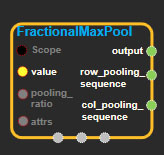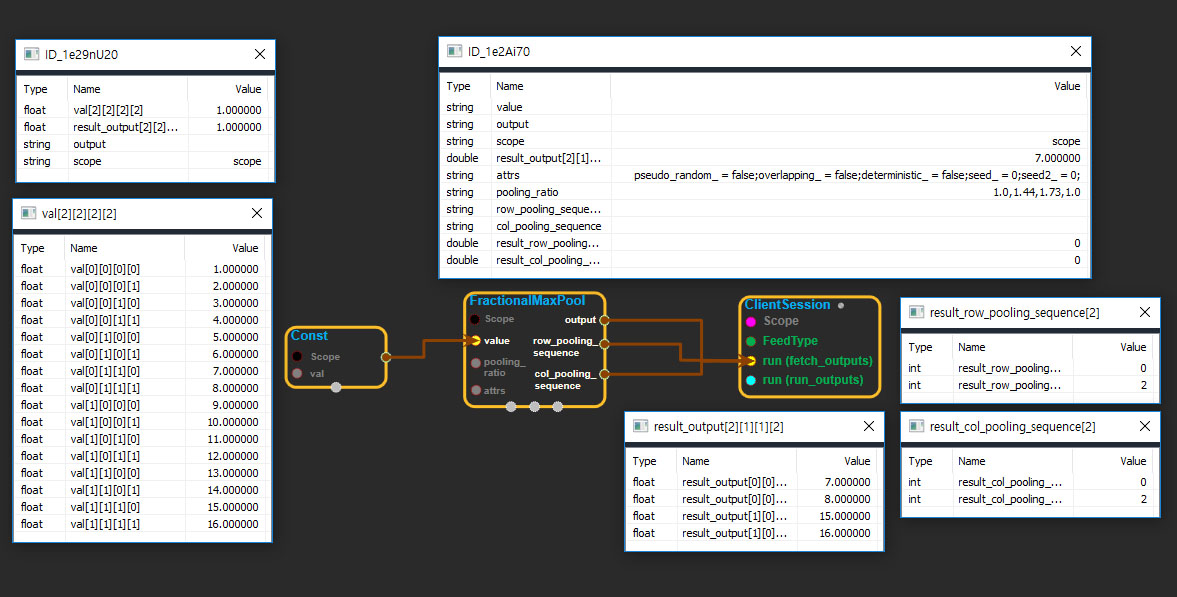FractionalMaxPool
tensorflow C++ API
tensorflow::ops::FractionalMaxPool
Performs fractional max pooling on the input.
Summary
Fractional max pooling is slightly different than regular max pooling. In regular max pooling, you downsize an input set by taking the maximum value of smaller N x N subsections of the set (often 2x2), and try to reduce the set by a factor of N, where N is an integer. Fractional max pooling, as you might expect from the word “fractional”, means that the overall reduction ratio N does not have to be an integer.
The sizes of the pooling regions are generated randomly but are fairly uniform. For example, let’s look at the height dimension, and the constraints on the list of rows that will be pool boundaries.
First we define the following:
- input_row_length : the number of rows from the input set
- output_row_length : which will be smaller than the input
- alpha = input_row_length / output_row_length : our reduction ratio
- K = floor(alpha)
- row_pooling_sequence : this is the result list of pool boundary rows
Then, row_pooling_sequence should satisfy:
- a[0] = 0 : the first value of the sequence is 0
- a[end] = input_row_length : the last value of the sequence is the size
- K <= (a[i+1] - a[i]) <= K+1 : all intervals are K or K+1 size
- length(row_pooling_sequence) = output_row_length+1
For more details on fractional max pooling, see this paper:Benjamin Graham, Fractional Max-Pooling
Arguments:
- scope: A Scope object
- value: 4-D with shape
[batch, height, width, channels]. - pooling_ratio: Pooling ratio for each dimension of
value, currently only supports row and col dimension and should be >= 1.0. For example, a valid pooling ratio looks like [1.0, 1.44, 1.73, 1.0]. The first and last elements must be 1.0 because we don’t allow pooling on batch and channels dimensions. 1.44 and 1.73 are pooling ratio on height and width dimensions respectively.
Optional attributes (seeAttrs):
- pseudo_random: When set to True, generates the pooling sequence in a pseudorandom fashion, otherwise, in a random fashion. Check paper Benjamin Graham, Fractional Max-Pooling for difference between pseudorandom and random.
- overlapping: When set to True, it means when pooling, the values at the boundary of adjacent pooling cells are used by both cells. For example:
index 0 1 2 3 4
value 20 5 16 3 7
If the pooling sequence is [0, 2, 4], then 16, at index 2 will be used twice. The result would be [20, 16] for fractional max pooling.
- deterministic: When set to True, a fixed pooling region will be used when iterating over a FractionalMaxPool node in the computation graph. Mainly used in unit test to make FractionalMaxPool deterministic.
- seed: If either seed or seed2 are set to be non-zero, the random number generator is seeded by the given seed. Otherwise, it is seeded by a random seed.
- seed2: An second seed to avoid seed collision.
Returns:
Outputoutput: output tensor after fractional max pooling.Outputrow_pooling_sequence: row pooling sequence, needed to calculate gradient.Outputcol_pooling_sequence: column pooling sequence, needed to calculate gradient.
FractionalMaxPool block
Source link : https://github.com/EXPNUNI/enuSpaceTensorflow/blob/master/enuSpaceTensorflow/tf_nn.cpp

Argument:
- Scope scope : A Scope object (A scope is generated automatically each page. A scope is not connected.)
- Input value: connect Input node.
- Input features: connect Input node.
- ArraySlice< float> pooling_ratio: Input pooling_ratio in value ex)1.0, 1.44, 1.73, 1.0
- FractionalAvgPool ::Attrs attrs : Input attrs in value. ex) pseudo_random_ = false;overlapping_ = false;deterministic_ = false;seed_ = 0;seed2_ = 0;
Return:
- Output output: Output object of FractionalAvgPool class object.
- Output row_pooling_sequence: Output object of FractionalAvgPool class object.
- Output col_pooling_sequence: Output object of FractionalAvgPool class object.
Result:
- std::vector(Tensor) result_output : Returned object of executed result by calling session.
- std::vector(Tensor) result_row_pooling_sequence : Returned object of executed result by calling session.
- std::vector(Tensor) result_col_pooling_sequence : Returned object of executed result by calling session.
Using Method
